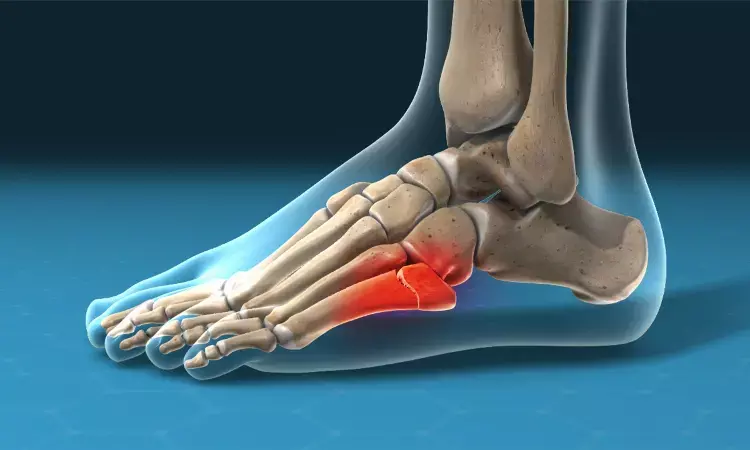- Home
- Medical news & Guidelines
- Anesthesiology
- Cardiology and CTVS
- Critical Care
- Dentistry
- Dermatology
- Diabetes and Endocrinology
- ENT
- Gastroenterology
- Medicine
- Nephrology
- Neurology
- Obstretics-Gynaecology
- Oncology
- Ophthalmology
- Orthopaedics
- Pediatrics-Neonatology
- Psychiatry
- Pulmonology
- Radiology
- Surgery
- Urology
- Laboratory Medicine
- Diet
- Nursing
- Paramedical
- Physiotherapy
- Health news
- Fact Check
- Bone Health Fact Check
- Brain Health Fact Check
- Cancer Related Fact Check
- Child Care Fact Check
- Dental and oral health fact check
- Diabetes and metabolic health fact check
- Diet and Nutrition Fact Check
- Eye and ENT Care Fact Check
- Fitness fact check
- Gut health fact check
- Heart health fact check
- Kidney health fact check
- Medical education fact check
- Men's health fact check
- Respiratory fact check
- Skin and hair care fact check
- Vaccine and Immunization fact check
- Women's health fact check
- AYUSH
- State News
- Andaman and Nicobar Islands
- Andhra Pradesh
- Arunachal Pradesh
- Assam
- Bihar
- Chandigarh
- Chattisgarh
- Dadra and Nagar Haveli
- Daman and Diu
- Delhi
- Goa
- Gujarat
- Haryana
- Himachal Pradesh
- Jammu & Kashmir
- Jharkhand
- Karnataka
- Kerala
- Ladakh
- Lakshadweep
- Madhya Pradesh
- Maharashtra
- Manipur
- Meghalaya
- Mizoram
- Nagaland
- Odisha
- Puducherry
- Punjab
- Rajasthan
- Sikkim
- Tamil Nadu
- Telangana
- Tripura
- Uttar Pradesh
- Uttrakhand
- West Bengal
- Medical Education
- Industry
Novel classification of avulsion fractures of the fifth metatarsal base using 3D CT and mechanism of injury.

Clinically, avulsion fractures of the fifth metatarsal base exhibit a diverse range of fracture morphologies, which have been beyond the description of existing classifications, but research on their fracture line characteristics is limited. Wenbao He et al conducted a study to clarify the injury mechanism of the avulsion fracture of the fifth metatarsal combining 3-dimensional (3D) fracture mapping with anatomical measurements.
Participants inclusion criteria included: (i) age≥18years; (ii) avulsion fracture of the fifth metatarsal base, acute injury.
Exclusion criteria included:
(i) avulsion fracture of the fifth metatarsal base comorbid with other fractures of the foot;
(ii) open fracture, pathologic fracture, or old fracture;
(iii) foot deformity or variation (i.e. hallux valgus, talipes equinus), history of foot surgery involving tendons, ligaments or bony structures (i.e. tendon transposition, ligament repair or internal fixation for fractures).
222 patients with the avulsion fractures of the fifth metatarsal base were included in the study. The computed tomography (CT) scans were used to generate the 3-D images of all mapped fracture lines for the avulsion fractures of the fifth metatarsal base were compiled in an overall 3D image. The fifth metatarsal base of 8 unpaired lower limbs of adult Asian frozen cadaveric specimens were also dissected to observe and measure the specific locations of the attachment points of the peroneus brevis, lateral band of the plantar fascia, and peroneus tertius to the fifth metatarsal base.
Based on the type of fracture line produced and the specific locations of the attachment points of the tendons or fascia, the avulsion fractures of the fifth metatarsal base can be classified into three types:
• Type I predominantly involves the action of the lateral band of the plantar fascia;
• Type II predominantly involves the action of the peroneus brevis;
• Type IIIA involves the joint action of the peroneus brevis and lateral band of the plantar fascia with one fracture line, and
• Type IIIB involves the joint action of the peroneus brevis and lateral band of the plantar fascia with two fracture lines.
The authors concluded that – "the avulsion fractures of the fifth metatarsal base produce various fracture lines. By examining their 3D distribution and anatomical features, this study has suggested that the lateral band of the plantar fascia and peroneus brevis play a major role in avulsion fractures of the fifth metatarsal base. Trauma to these structures can occur separately or together, so we have proposed a novel classification for such fractures, which can serve as a reference for clinical treatment and diagnosis."
Level of evidence: Level III, retrospective case series.
Further reading:
Classification of avulsion fractures of the fifth metatarsal base using three-dimensional CT mapping and anatomical assessment: a retrospective case series study
Wenbao He, Haichao Zhou et al
Journal of Foot and Ankle Research (2022) 15:65
https://doi.org/10.1186/s13047-022-00571-2
MBBS, Dip. Ortho, DNB ortho, MNAMS
Dr Supreeth D R (MBBS, Dip. Ortho, DNB ortho, MNAMS) is a practicing orthopedician with interest in medical research and publishing articles. He completed MBBS from mysore medical college, dip ortho from Trivandrum medical college and sec. DNB from Manipal Hospital, Bengaluru. He has expirence of 7years in the field of orthopedics. He has presented scientific papers & posters in various state, national and international conferences. His interest in writing articles lead the way to join medical dialogues. He can be contacted at editorial@medicaldialogues.in.
Dr Kamal Kant Kohli-MBBS, DTCD- a chest specialist with more than 30 years of practice and a flair for writing clinical articles, Dr Kamal Kant Kohli joined Medical Dialogues as a Chief Editor of Medical News. Besides writing articles, as an editor, he proofreads and verifies all the medical content published on Medical Dialogues including those coming from journals, studies,medical conferences,guidelines etc. Email: drkohli@medicaldialogues.in. Contact no. 011-43720751


